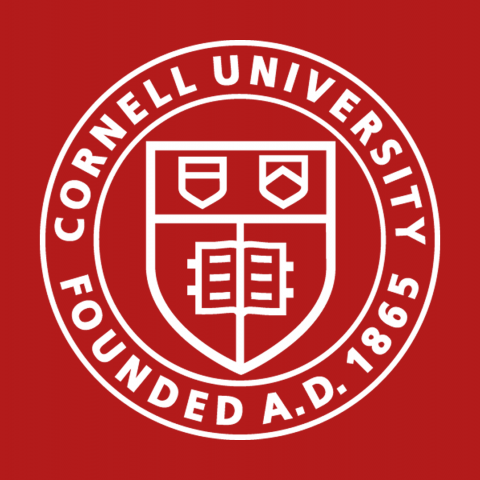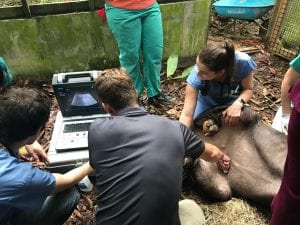Updates from the Belize Zoo: A Case Study on a Tapir

In 2011, Cornell’s College of Veterinary Medicine and The Belize Zoo partnered under the guidance of Jay Hyman Professor of Zoological Medicine, George Kollias Jr, DVM DACZM. Since then, Cornell has sponsored veterinary students and faculty on over ten trips to Belize. I had the worthwhile opportunity to be on the June 2018 trip with seven other veterinary students as well as faculty, residents, and technicians from the CUHA sections of Dentistry and Oral Surgery, Anesthesia, and Zoological Medicine. As an aspiring zoo and wildlife veterinarian, this trip was a wonderful chance to receive personalized instruction and gain hands-on experience with a diverse group of Central American species. 
Upon entering the Belize Zoo, we were immediately consumed by the sights and sounds of local flora and fauna, becoming fully immersed into a jungle-like setting. All of the bio-parks’ animal residents are indigenous to the country and unfortunately, are non-releasable for a multitude of reasons. The Belize Zoo provides animals such as the kinkajou, harpy eagle, crocodile, boa constrictor, and tapir with a safe, comfortable home and sponsors them as educational ambassadors for their wild-counterparts. We were welcomed into the Belize Zoo Clinic, where we were introduced to our cases for the week. Cases included: a mass removal procedure on a Tayra (Eira barbara), physical exams and tuberculin tests on five Black Howler Monkeys (Alouatta pigra), a root-canal on a jaguar (Panthera onca), and venipuncture on toucans (Ramphastos sulfuratus).
My favorite case was a newly acquired Central American Tapir (Tapirus bairdii) requiring a physical exam and pregnancy evaluation. The Central American Tapir is the national animal of Belize and is the largest land mammal in the country; this species of “mountain cow” ranges from Southern Mexico to Northern Colombia and is endangered throughout its natural range due to hunting and deforestation. “Lourdess”, as the zoo staff named her, was a female intact, Central American Tapir estimated to be in her late adult life. She was acquired by the zoo after she was found to be thin and distressed in an area outside her natural habitat. Dr. Kollias led the well-orchestrated, multi-disciplinary examination in the animal’s off-exhibit enclosure. It was our hope that she could be examined and rehabilitated if possible.

Lourdess was sedated with a combination of ketamine and detomidine intramuscularly by anesthesia resident and faculty member, Dr. Erika Militana and Dr. Jordyn Boesch, respectively. When she was sedated, students began monitoring her vital signs such as respiratory rate, heart rate, temperature, and pulse oximetry. Respiratory rates varied between 20-32 breaths per minute while her heart rate remained fairly constant at approximately 40 beats per minute, consistent with past studies regarding chemical restraint in tapirs. In order to reduce stress, the physical exam was split into teams. The head, neck, and oral cavity of Lourdess were assessed by dentistry and oral surgery resident and faculty member, Dr. Lindsey Schneider and Dr. Santiago Peralta, respectively. Meanwhile, Dr. Andrew Cushings, professor from the University of Tennessee (former Zoological Medicine resident at Cornell), conducted an ultrasound-guided pregnancy check to evaluate whether her uterus was gravid. Blood and a fecal sample were also obtained by wildlife technician Tina Hlywa. This procedure was done efficiently in less than 45 minutes, leaving Lourdess with her keeper to wake up peacefully inside the enclosure. Students continued to monitor her recovery from the gate.
After Lourdess returned to her normal behavior, we returned to the clinic to debrief on her physical exam and diagnostics. As a previously free-ranging tapir, she was found to have moderate changes in her eyes, likely due to age, as well as significant discharge in both ears. Nose and nares were considered normal. On oral examination, there were abnormalities on her maxillary cheek teeth, so intraoral radiographs were performed. Heart and lung sounds demonstrated no abnormalities. Her limbs and feet were normal, with some scarring lesions in her axillary region. Overall, ultrasound confirmed that she was not pregnant. Body condition score was a ⅖. Initial diagnostics of the blood work demonstrated a Packed Cell Volume (PCV) of 26% and TP value of 6.6 g/dl , both of which were within normal limits compared to studies of the same species of tapir in Costa Rica. Recommendations were made to increase her free choice diet, offer supplements, and schedule a follow-up dental exam and probable cheek tooth extraction in January. Since her exam, she has been doing well and gaining weight. In such a short amount of time, the other students and I were able to practice necessary clinical skills such as using an ultrasound probe to evaluate the heart and monitor the vitals of a sedated animal. One of my favorite skills was learning how to consult the literature on species-specific reference intervals to determine if certain values were considered normal or abnormal.

This opportunity would not have been possible without the the Belize Zoo staff such as Director, Sharon Matola, and General Curator, Humberto, in collaboration with Dr. George Kollias. Our group was privileged to be able to witness the unveiling of the Belize Zoo Clinic on Friday afternoon, at the end of a busy work week. The Belize Zoo Clinic has been in the works for many years and received funding from a variety of sponsors including Cornell’s College of Veterinary Medicine. At its opening, the zoo staff and donors honored Dr. Kollias for all of his hard work in advocating on the clinics’ behalf with a plaque next to the clinic’s double doors. Once just a hopeful idea, this clinic is now fully functional with a working pharmacy, intake area, and surgery suite. This is just one example of how the Belize Zoo works diligently to provide the best care to its animal residents.j
Acknowledgements
Thank you to all of the faculty, residents, and students that I learned from on this trip. Special thanks to Dr. Kollias and the staff of the Belize Zoo. This was a once in a lifetime opportunity!
ABOUT THE AUTHOR:
Victoria Albano, class of 2021, is a veterinary student from Staten Island, NY. She received her Bachelor’s from Cornell University in May of 2015, with a major in Animal Science. She is excited about zoo medicine working in conjunction with conservation education. She hopes one day to work as a zoo or wildlife veterinarian. If anyone has any questions or would like to talk more about this opportunity, please feel free to email her – vra23@cornell.edu

